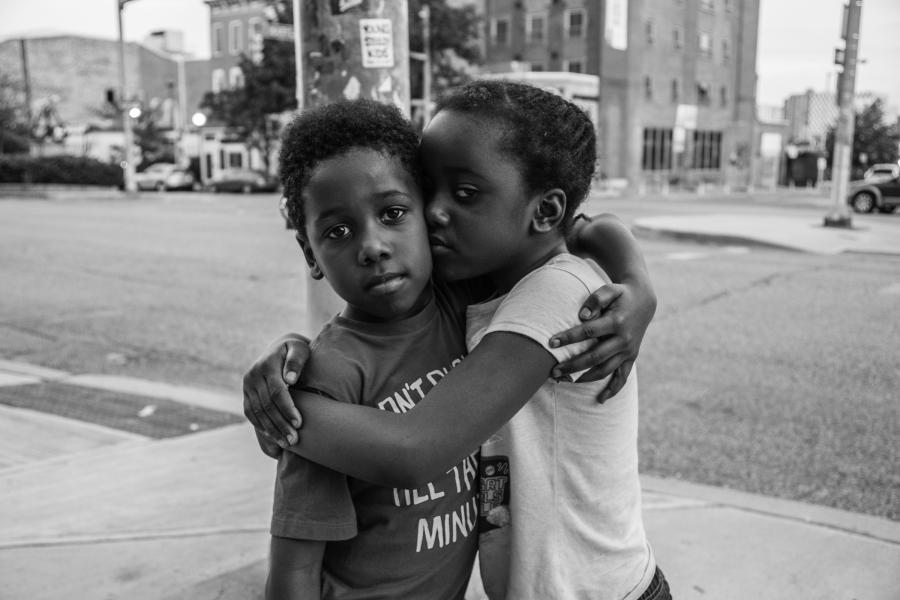If pictures could talk, Baltimore-based photographer SHAN Wallace's "The Oldest and the Middle" would utter, I've got you.
The photo depicts a brother and sister wrapped in each other's arms in downtown Baltimore. "When I asked to take their photograph, they said, 'Let's show the world how much we love each other,'" says Wallace, who struck up a conversation with the siblings in Station North one day.
For Wallace, who grew up in East Baltimore, her hometown offers community and opportunity that few realize. "People know Baltimore from the flood of media surrounding the Freddie Gray riots in 2015," she says. "They know it for the gang violence in The Wire." With her art, Wallace reveals a different side of her hometown—one that shows the human side of individuals living there: a young boxer preparing for a match, a market vendor selling fried chicken, a mother waiting for a bus.
A similar sense of hometown pride lies at the heart of Johns Hopkins University's recent purchase of nine art pieces by Baltimore-based artists intent on celebrating the vitality of a place outsiders sometimes see only through the fog of stereotypes. In addition to Wallace, the roster of artists includes LaToya Hobbs, Linling Lu, Sebastian Martorana, Ernest Shaw, and Elena Volkova. Collectively, they represent a diverse group of visionary artists working at the forefront of their fields. With their work soon headed to Johns Hopkins campuses, they will help to set a new visual narrative for a city steeped in difficulty yet teeming with positivity.
A painter and printmaker, Hobbs explores themes like motherhood and spirituality through her larger-than-life portraits of Black women, while Lu works in the realm of the abstract, painting concentric circles in vibrant colors. Martorana, a sculptor, culls pieces from Baltimore's discarded (yet historical) architecture, and Volkova depicts people on thin sheets of metal, reviving a Victorian-era form of photography, tintypes. Shaw, meanwhile, is a portrait painter striving to humanize and shed light on the Black experience.
"When I moved here four years ago, I was blown away by the abundance of artists and their immense motivation to create," says Jessica Bell Brown, the curator and department head of contemporary art at the Baltimore Museum of Art, which owns pieces by Wallace, Volkova, Lu, Shaw, and Hobbs. "Economically, the city has become a reprieve from the exorbitant expenses of LA and New York. That factor, combined with the incredible intellectual life in Baltimore, has created alchemy."
Yet artists attempting to make it internationally often don't exhibit locally, booking shows instead in global art meccas like London, New York, Istanbul, and Tokyo, says Cara Ober, editor-in-chief of BmoreArt magazine, who partnered with Johns Hopkins to help with art selection. This is where Johns Hopkins can make a difference, "serving as a local venue that showcases Baltimore art, while supporting artists as they grow and evolve in their careers," Ober says.
Ober believes the investment will benefit not just the artists or those who see their work but also the larger university. Savvy art collectors buy from flourishing artists who haven't yet achieved wide notoriety, Ober suggests. "Etta and Claribel Cone weren't collecting famous artists at the time," Ober says of the sisters who amassed and bequeathed more than 3,000 art objects—many by Henri Matisse and Pablo Picasso—to the Baltimore Museum of Art. "They were collecting artists they believed in … [and] saw value in, when others did not."
For the six artists, displaying their work in places that both the public and university community can access and explore at Johns Hopkins is exciting. "I'm thrilled to see a top institution like Hopkins invest in a new visual narrative for Baltimore, and I hope it's the start of a long-term partnership," Wallace says. Shaw says he hopes for the same and believes art can open minds and transform perceptions.
In Shaw's "New Squeegee Boys" purchased by Johns Hopkins, the artist attempts to overturn negative stereotypes and "illustrate a more complete picture of the lived experience of the Baltimore kids who wash car windows for money," he says. His painting depicts two teens who cleaned windows on the corner of North and Maryland avenues. "I saw them out squeegeeing in a downpour of rain, and it hit me: These kids aren't out there by choice," he says. "They're out there as a last-ditch effort to salvage their humanity [after growing up with hardships]."
In this painting and others, Shaw integrates African iconography to remind viewers of the African roots of many Black people in the United States. Masks from the Dogon ethnic group in Mali enshrine the teens' faces, while the squeegees call to mind the crooks and flails carried by Egyptian pharaohs. "I'm trying to dispel the myth that everything our enslaved ancestors brought from Africa was erased," Shaw says. "There's too much evidence to suggest that African Americans are still African—and that the history, science, and culture prior to 1619 lives on in Baltimore and elsewhere."
Posted in Arts+Culture, University News








